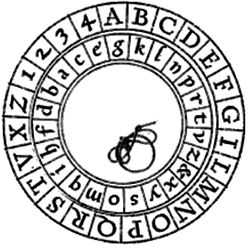Alberti cipher disk

The Alberti cipher disk, also called formula, is a cipher disc which was described by Leon Battista Alberti in his treatise De Cifris of 1467. The device embodies the first example of polyalphabetic substitution with mixed alphabets and variable period, and is made up of two concentric disks, attached by a common pin, which can rotate one with respect to the other.
The larger one is called Stabilis [stationary or fixed], the smaller one is called Mobilis [movable]. The circumference of each disk is divided into 24 equal cells. The outer ring contains one uppercase alphabet for plaintext and the inner ring has a lowercase mixed alphabet for ciphertext.
The outer ring also includes the numbers 1 to 4 for the superencipherment of a codebook containing 336 phrases with assigned numerical values. This is a very effective method of concealing the code-numbers, since their equivalents cannot be distinguished from the other garbled letters.
The sliding of the alphabets is controlled by key letters included in the body of the cryptogram.
First method of encipherment
A lowercase letter on the smaller ring is used as an index.
In this example the letter g in the inner ring is chosen as an index and is moved under an uppercase letter (in this case A) of the stationary ring. The alphabets in use are (see figure):
ABCDEFGILMNOPQRSTVXZ1234 Stationary disk
gklnprtuz&xysomqihfdbace Movable disk
Dispatch: “La guerra si farà ...”
_LAGVER2RA_ Plaintext
AzgthpmamgQ Ciphertext
The key letters A and Q are included in the cryptogram. The small letter a resulting from the encipherment of the number 2 is a null and must be discarded in the decipherment.
After enciphering a few letters a different uppercase letter (Q) is inserted in the cryptogram and the movable disk is accordingly rotated obtaining a new combination:
QRSTVXZ1234ABCDEFGILMNOP Stationary disk
gklnprtuz&xysomqihfdbace Movable disk
The encipherment will resume thus:
_SIFARÀ Plaintext
Qlfiyky Ciphertext.
The same procedure will be continued with different key letters through the end of the message.
Second method of encipherment
An uppercase letter in the stationary disk is used as an index.
In this example the letter A is chosen as an index and the small m of the movable disk is juxtaposed to the index letter. The changes of alphabets will be indicated by enciphering one of the four numbers.
ABCDEFGILMNOPQRSTVXZ1234 Stationary disk
mqihfdbacegklnprtuz&xyso Movable disk
Dispatch: “La guerra si farà ..."
_LAGVERA3 Plaintext
mcmbufpms Ciphertext
One of the two R’s is omitted to defy cryptanalysis. The presence of the letter s enciphering the number 3 indicates the need for turning the movable disk to a new position. The letter s is then moved under the letter A.
ABCDEFGILMNOPQRSTVXZ1234 Stationary disk
somqihfdbacegklnprtuz&xy Movable disk
The encipherment will resume thus:
_SIFARÀ Plaintext
sndhsls Ciphertext
The same procedure will be continued through the end of the message, using the four numbers to designate the alphabet shifts.
The Alberti disk encipherment has nothing to do with Affine Shifts, Keyword shifts, Caesar shift or Vigenère ciphers. Caesar’s cipher is a simple substitution based on the sliding of a single ordinary alphabet with fixed key. Once the equivalent of a letter is discovered all the equivalent cipher letters are known. With the Alberti cipher there are two mixed alphabets and the key varies continuously during encryption, therefore the discovery of a single letter does not permit further progress. Frequency analysis is also impossible because the same letter is always enciphered differently. The Vigenère cipher is based on a single ordinary alphabet like that of Caesar and is easily solved after discovering its fixed period by means of the Kasiski exam. This is not possible with Alberti.
References
- Alberti, Leon Battista, A Treatise on Ciphers, trans. A. Zaccagnini. Foreword by David Kahn, Galimberti, Torino 1997.
- Buonafalce, Augusto, “An Exercise in Solving the Alberti Disk”. The Cryptogram LIV, 5, ACA, Plano 1999.